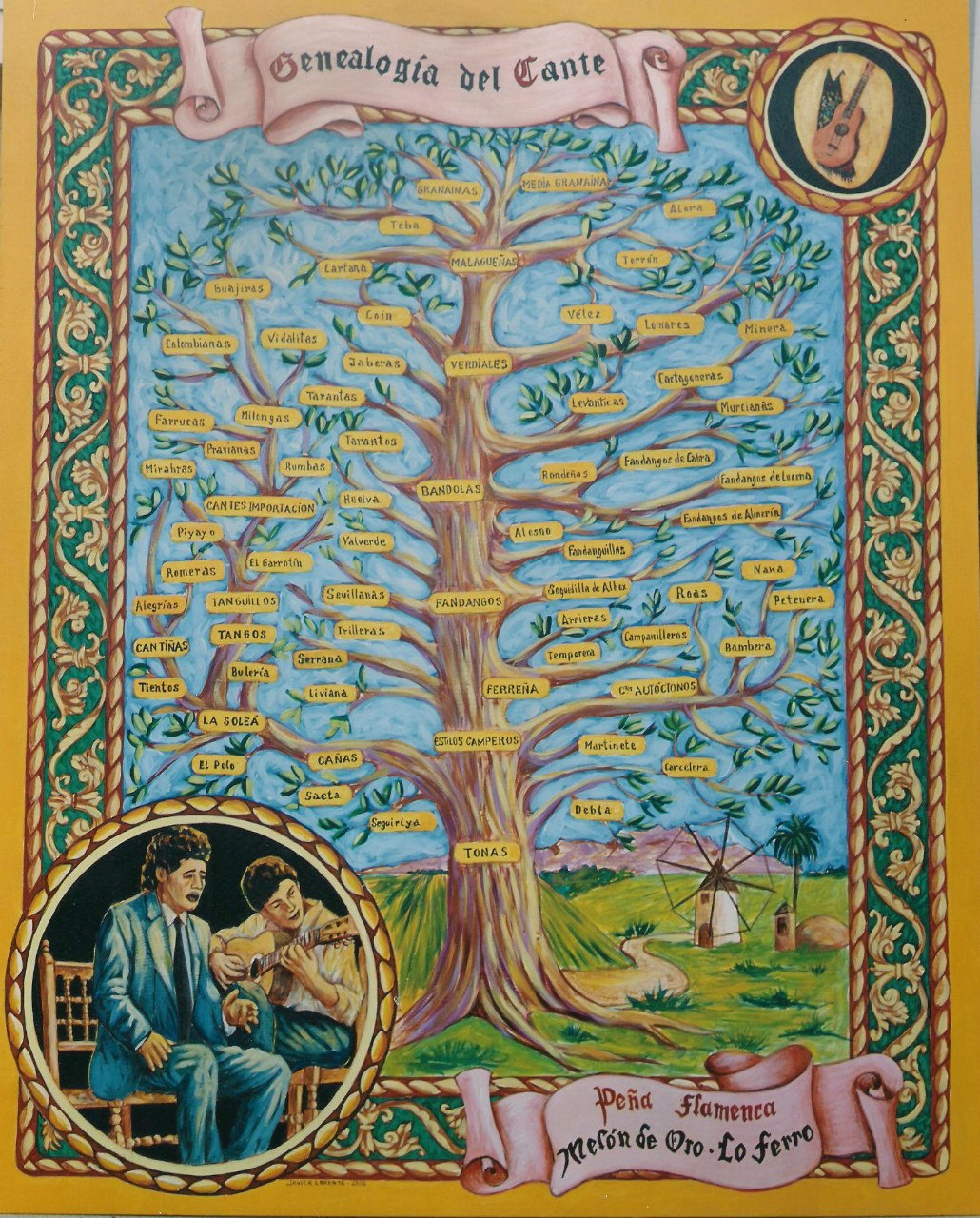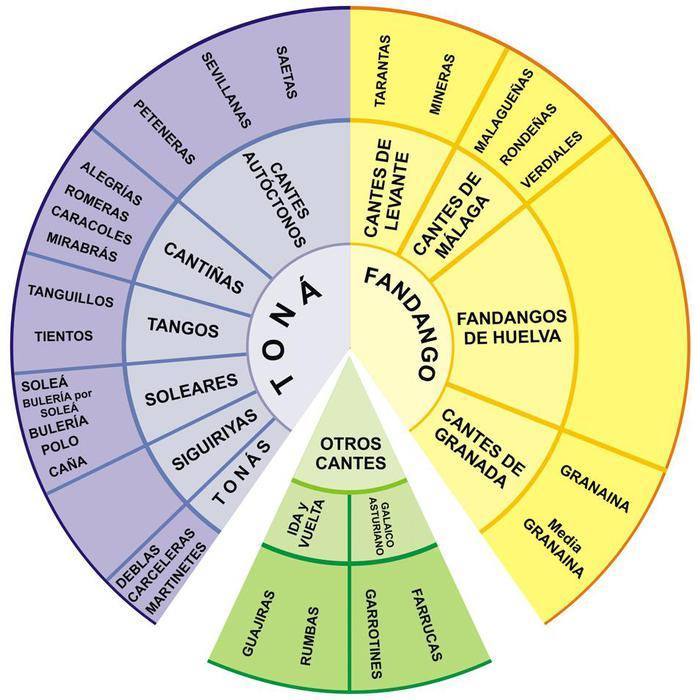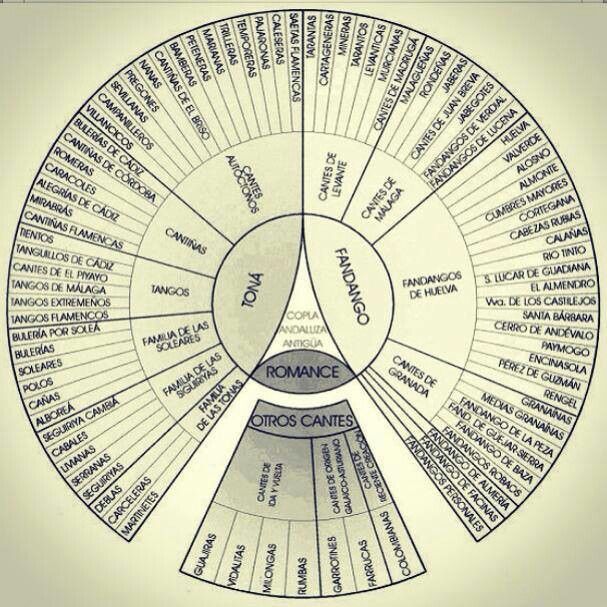flamenco
Flamenco sounds (Sones Jondos)
The flamenco sounds (sones jondos) are the oldest part of the flamenco art. Their name comes from the sing called deep in which the artist must search inside himself to find his deepest feelings. The Flamenco Sing is sang in an ancient way with traditional lyrics and topics with elements valued by the flamenco lovers such as emotional expressivity.

The topics include the hard day life of miners, the joy of having a ship, or the different emotions such as mourning or injustice
Serranas
“La Serrana”is a flamenco style song with four verses of pair rhythm, the first and the third of seven syllables and the second and fourth with five syllables. To this copla is added a trio in his verses rhyming the first and the third verses of five syllables, while the second, of seven syllables, remains alone. This song is accompanied by the beat of the seguiriyaand it is saidand admitted that its origins lie
in the Serrania de Ronda, and were the smugglers and bandits the pioneers in singing them in the first half of the nineteenth century. The first reference we have of this dance is in 1953 when Antonio Ballet premiered at the Festival of Granada; José de la Vega applauded them in 1955 at the Theatre Champs Elysees in Paris. Also danced by Flora Albaicín and Manolo Vargas in 1958, there is no agreement on who were the pioneers.
Cabales
The cabales are the a variation of the seguiriyas, singed in other intonation. It is like a personalized chorus. Its creation is attributed to Silverio Franconetti.
Seguiriya
From the word seguidilla come the variations: seguiriya, seguirilla, siguiriya o siguerilla. It is one of the most ancient variations of the flamenco. It is considered the most emblematic flamenco sing which comes from the tonás that appeared between Cádiz and Seville, in the harbours of Jerez and the neighbourhood Triana. It is a dark singing with traditional values. The lyrics are tragic and show the suffering of the human relations, love and death. It is also called gypsy seguiriya because they used it to express their troubles. The lyrics show the pain of the gypsy people, alienated from the society for three centuries. It is also a crucial point in the flamenco because with the seguiriya the singing mixed with the guitar. In the dancing, after Vicente Escudero, were performed also by female dancers such as Pilar López who add the sound of the castanets. The seguiriya singed by Manolo Caracol and danced by Pilar López and Luisa Ortega in 1956 in the show Torres de España was unforgettable.
Saeta
According to Carlos Almendros we can considerate the Saeta a Byzantine-Mozarab singing that the town mixed with romances or tonás. Some theorists name Enrique el Mellizo and Manuel Centero the creators of this variation; others also name Antonio Chancón and Manuel Torres.
“La Serrana”is a flamenco style song with four verses of pair rhythm, the first and the third of seven syllables and the second and fourth with five syllables. To this copla is added a trio in his verses rhyming the first and the third verses of five syllables, while the second, of seven syllables, remains alone. This song is accompanied by the beat of the seguiriyaand it is saidand admitted that its origins lie
in the Serrania de Ronda, and were the smugglers and bandits the pioneers in singing them in the first half of the nineteenth century. The first reference we have of this dance is in 1953 when Antonio Ballet premiered at the Festival of Granada; José de la Vega applauded them in 1955 at the Theatre Champs Elysees in Paris. Also danced by Flora Albaicín and Manolo Vargas in 1958, there is no agreement on who were the pioneers.
Cabales
The cabales are the a variation of the seguiriyas, singed in other intonation. It is like a personalized chorus. Its creation is attributed to Silverio Franconetti.
Seguiriya
From the word seguidilla come the variations: seguiriya, seguirilla, siguiriya o siguerilla. It is one of the most ancient variations of the flamenco. It is considered the most emblematic flamenco sing which comes from the tonás that appeared between Cádiz and Seville, in the harbours of Jerez and the neighbourhood Triana. It is a dark singing with traditional values. The lyrics are tragic and show the suffering of the human relations, love and death. It is also called gypsy seguiriya because they used it to express their troubles. The lyrics show the pain of the gypsy people, alienated from the society for three centuries. It is also a crucial point in the flamenco because with the seguiriya the singing mixed with the guitar. In the dancing, after Vicente Escudero, were performed also by female dancers such as Pilar López who add the sound of the castanets. The seguiriya singed by Manolo Caracol and danced by Pilar López and Luisa Ortega in 1956 in the show Torres de España was unforgettable.
Saeta
According to Carlos Almendros we can considerate the Saeta a Byzantine-Mozarab singing that the town mixed with romances or tonás. Some theorists name Enrique el Mellizo and Manuel Centero the creators of this variation; others also name Antonio Chancón and Manuel Torres.


Nothing is written. The flamenco is an oral tradition, just the music for guitar has been transcribed to paper.
Martinete
The name Martinete comes from the hammer (martillo in Spanish) the blacksmiths used to mould the iron. This variation was dramatized for the flamenco shows. For more than one and a half century this moan was sung a lot and one day in 1952 the dancer from Seville Antonio danced it and then was immortalized by Edgar Neville in the film “Duende y Misterio Flamenco”.
Debla
Flamenco experts talk about the origin of the debla. Antonio Machado Álvarez, father of the poets Antonio and Manuel Machado, known as Demófilo said: “The word debla is gypsy and means goodness”. It is a variation of the martinete and a very difficult one to perform. The Debla is similar to a Toná. Its recording in 1950 brought trouble with his brother Arturo because it was exclusive of the gypsy people. In 1969 the dancer Merche Esmeralda in the tablao Los Gallos de Servilla, performed an original Debla. The dancer danced at the compass of martinete for the "cabal de seguiriya", in a staging by Matilde Coral.
The name Martinete comes from the hammer (martillo in Spanish) the blacksmiths used to mould the iron. This variation was dramatized for the flamenco shows. For more than one and a half century this moan was sung a lot and one day in 1952 the dancer from Seville Antonio danced it and then was immortalized by Edgar Neville in the film “Duende y Misterio Flamenco”.
Debla
Flamenco experts talk about the origin of the debla. Antonio Machado Álvarez, father of the poets Antonio and Manuel Machado, known as Demófilo said: “The word debla is gypsy and means goodness”. It is a variation of the martinete and a very difficult one to perform. The Debla is similar to a Toná. Its recording in 1950 brought trouble with his brother Arturo because it was exclusive of the gypsy people. In 1969 the dancer Merche Esmeralda in the tablao Los Gallos de Servilla, performed an original Debla. The dancer danced at the compass of martinete for the "cabal de seguiriya", in a staging by Matilde Coral.
Soleá. Author: anonymous
“La noche del aguacero
dime donde te metiste
que no te mojaste el pelo”
The night of the downpour
tell me where did you get
so your hair didn’t get wet.
Soleá
It is the mother of several singings with the same compass; the spine of the flamenco dance. But who hasn’t felt alone? With the soleá is expressed the sadness of that harm, because of the abandon of the loved one or an impossible love. In its lyrics are reflected many feelings of the soul.
Caña and polo
They are derivatives from the soleá. They are distinguished by the “wailing” of the guitar, a melody which later was followed by the sing. The monosyllabic “ayes” throughout which the singer expresses his moan are substituted in the caña for “aes”, chained to the metrics. One of the differences with the polo is that uses the “o” instead. Both have a final variation called "macho”. In the dancing, the caña had Pilar López as its most important performer. In the film “Duende y misterio del flamenco” Edgar Neville filmed the dancer Alejandro Vega, the dancer believed to be Pilar López favourite partner to dance this style. Another famous caña is Antonio's caña, sung by Antonio Mairena and accompanied by the famous guitarist Manuel Morao.
Taranta, taranto, minera, cartagenera
Taranto is the name given to everything that is born in Almería. It is said that it is a variety of the fandango. Emigrants from Almeria spread through their close provinces but they are original from Almería, Jaén and Murcia. This sing comes from the throat with screams of grief. The Taranto has the echoes of the mines and the anguish of the miners. It is distinguished from the taranta because it has the compass of the zambra. From the Taranto derive the mineras and cartageneras. In the dance, the taranto set up a great change in the beginning of the fifties of last century by the great dancer Rosario. Not everyone dared to dance it. After her others did it like Flora Albaicín and Carmen Rojas in the Antonio’s Ballet. It was also famous the Taranto of Carmen Mora, Merche Esmeralda and Cristina Hoyos.
It is the mother of several singings with the same compass; the spine of the flamenco dance. But who hasn’t felt alone? With the soleá is expressed the sadness of that harm, because of the abandon of the loved one or an impossible love. In its lyrics are reflected many feelings of the soul.
Caña and polo
They are derivatives from the soleá. They are distinguished by the “wailing” of the guitar, a melody which later was followed by the sing. The monosyllabic “ayes” throughout which the singer expresses his moan are substituted in the caña for “aes”, chained to the metrics. One of the differences with the polo is that uses the “o” instead. Both have a final variation called "macho”. In the dancing, the caña had Pilar López as its most important performer. In the film “Duende y misterio del flamenco” Edgar Neville filmed the dancer Alejandro Vega, the dancer believed to be Pilar López favourite partner to dance this style. Another famous caña is Antonio's caña, sung by Antonio Mairena and accompanied by the famous guitarist Manuel Morao.
Taranta, taranto, minera, cartagenera
Taranto is the name given to everything that is born in Almería. It is said that it is a variety of the fandango. Emigrants from Almeria spread through their close provinces but they are original from Almería, Jaén and Murcia. This sing comes from the throat with screams of grief. The Taranto has the echoes of the mines and the anguish of the miners. It is distinguished from the taranta because it has the compass of the zambra. From the Taranto derive the mineras and cartageneras. In the dance, the taranto set up a great change in the beginning of the fifties of last century by the great dancer Rosario. Not everyone dared to dance it. After her others did it like Flora Albaicín and Carmen Rojas in the Antonio’s Ballet. It was also famous the Taranto of Carmen Mora, Merche Esmeralda and Cristina Hoyos.
